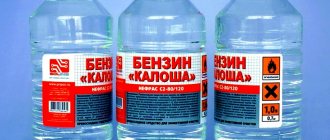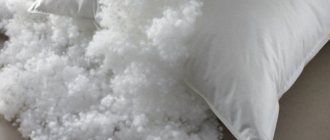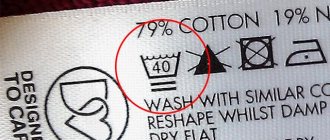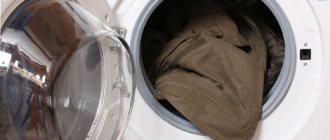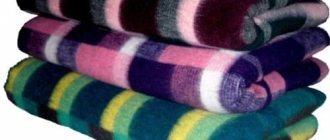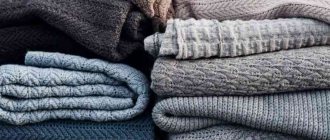When we buy something new, we want to become the owner of a quality item. I want it to serve for a long time. We will tell you how to wash thermal underwear in a washing machine and what is important to pay attention to.
With the onset of cold weather, the popularity of underdress clothing is growing significantly. It advantageously combines lightness and high thermal protection.
Such things are made of special material. It has a cell structure that resembles the texture of leather.
It is this technology that ensures proper thermoregulation. This material allows moisture to evaporate, but at the same time retains heat.
How to wash clothes to preserve their unique properties? Is a washing machine suitable for this purpose?
How it works
Similar insulation materials were invented specifically for athletes. Over time, this miracle of modern science and advanced technology has come into our everyday life.
It quickly gained popularity. The fibers in the fabric are woven in such a way as to remove moisture and retain heat. Heat losses are minimal.
There are three types of thermal underwear:
- moisture-removing;
- heat-saving;
- hybrid.
The principle is simple. A layer of air is created in the fabric. It comes into contact with the skin and acquires the desired temperature. In such clothes this layer is constantly preserved. It protects against exposure to cold.
For this purpose, volumetric and cellular weaving is used. It helps increase air volume. The linen is quite light and thin.
Moisture-wicking underwear can remove excess moisture. Such things are 100% synthetic.
The hybrid combines the properties of the first two types. It is warm and helps get rid of moisture. In such products, the heat-saving material is thinner or denser than the moisture-wicking fabric.
Sometimes thermal underwear is made in two layers for this purpose. Synthetics are used for the bottom layer, and either heat-saving synthetics or natural fabric are used for the top layer.
As you can see, such things have a rather complex fiber structure. They can have a varied composition. In any case, they are very delicate and easily deformed.
That's why you need to be very careful with them.
Bleaching things
It is prohibited to use chlorine-containing products for thermal underwear, as they can damage the structure of the fabric. This will lead to loss of quality characteristics.
If it is necessary to restore white products that have turned gray from long-term use, then the most gentle ones are selected from the assortment offered by manufacturers. Then bleaching will not have a negative impact, preserving all the operational properties of thermal underwear aimed at preserving heat when worn.
You can use the new generation soft oxygen bleach BOS Plus. It is added to the container with detergents - 40 ml and the mode recommended for a particular type of laundry is set.
Efficiency appears already at a water temperature of 30 degrees, so deformation of the products can be avoided. It is easy to rinse without remaining in the pores of the fabric.
Oxygen bleach BOS Plus
Is it machine washable?
Since thermal underwear is highly permeable to moisture, it gets dirty very quickly. The task of these things is to maintain the temperature of the human body in cold weather.
When such clothes become dirty, they are as poorly permeable to moisture as the clogged pores of human skin.
Note! It is impossible to determine soiled laundry by smell. The fabric for it consists of special fibers. They are intertwined in such a way that they do not retain the smell. How do you know when it's time to update it? Experts advise doing this more often. If we are talking about sports training, then it is better to do this after each visit to the gym. Well, those that you just wear every day should be rinsed a couple of times a week. Remember that outerwear with a thermal effect should not be subjected to frequent water treatment.
Important! Many people believe that this category should not be sent to the typewriter. This is mistake. You just need to read the label carefully. If automatic washing is contraindicated or there are restrictions, this will be indicated on it.
Thermal underwear can be washed both by hand and in a machine. The last option is considered the most convenient.
You can even load thermal socks into the machine. The main requirement is to establish a delicate regime. Before you start the washing process, you need to carefully study the tag.
Explanation of the label
To clean thermal underwear using safe means, including without using a machine, you need to carefully consider the symbols indicated on the label (Figure 5).
Figure 5. The label contains all the necessary information for caring for clothing
A schematically depicted container of water indicates that the clothes can only be washed by hand. If it is accompanied by a crossed out image of a washing machine, you should have no doubt at all that you will have to act without using technology.
The numbers indicated in or near the water container indicate the maximum water temperature suitable for washing.
A crossed out triangle means that it is prohibited to use bleach to wash the product. The iron shown schematically shows whether the product can be ironed or shipped. If the icon is crossed out, this is not recommended. If there is one dot on the iron symbol, then the product can be ironed, but the temperature should not exceed 110 degrees, and for ironing you need to use a damp cotton cloth.
A crossed out circle means that the product is not suitable for dry cleaning. A crossed out circle in a square indicates that clothes should not be wrung out or dried in a washing machine.
Important Rules
If you have studied the label and decided to use the machine, remember these simple conditions:
- Set the temperature no higher than 40 degrees.
- Choose the delicate mode.
- Do not use powder, but a special detergent. It is liquid and washes out easily.
- If there is no liquid product, you can replace it with simple soap.
- You can use an antistatic agent, conditioner, and rinse aid.
- Don't even think about spinning. This will lead to inevitable loss of shape.
- Please note that materials such as Polartek and polyester absolutely cannot withstand contact with hot water. Information about the composition can be found on the label.
- Do not use stain remover.
- After washing, rinse the clothes thoroughly.
- Wet clothes should be carefully hung over a bowl or bathtub to allow the water to drain.
Which laundry detergent to choose
Not all powders and gels are suitable for thermal underwear. More precisely, no powder will do. And all because of the same cellular structure of the fabric: powder particles clog into the pores and interfere with the normal functioning of the air gap. In addition, during physical activity a person sweats, the sweat mixes with powder residues, and this mixture, in contact with the skin, can cause irritation.
More than 100 cool lessons, tests and exercises for brain development
Start developing
Here are some of the most common options for washing:
- A special gel is a product that is marked “for thermal underwear.” Just be sure to look at what fabric composition it is suitable for, since it is usually ideal for synthetics. As an example: Heitmann Spezial Waschpflege, Meine Liebe Sport, Nordland Sport, Synergetic for sportswear, etc.
- Detergent for washing woolen products - also has a liquid form and is suitable for cleaning items made from merino wool or mixed materials that contain wool.
- Laundry soap (can be replaced with soap for children's clothing) - will be needed during the manual cleansing procedure. Just keep in mind that you should not rub the material with the bar: this will clog and damage the fibers. I’ll tell you how to prepare a soap solution in the next section.
- Hair shampoo - if none of the above is on hand, then you can take a colorless transparent hair shampoo. Colored liquids with mother-of-pearl and sparkles are not suitable.
- Oxygen bleaches - they can be used only in exceptional cases to return the undergarment to its original whiteness.
- Dish detergent – it is not recommended to use it for full washing, as it is difficult to rinse out and “clogs” the fabric. But if you put a greasy stain on your suit, then delicate compounds will not cope with it, but “Fairy” or something similar will do. Apply a small amount of gel to a dry spot and leave for 10-15 minutes. Afterwards, rinse gently with water.
To prevent the item from becoming deformed and losing its properties, do not add conditioner. Chlorine-containing stain removers and bleaches are strictly prohibited.
Drying correctly
Washing the insulation is only half the battle. It is important to dry it properly. How competently you do this will directly determine whether the thing will retain its shape and properties.
The purpose of drying is to preserve the original appearance of the product as much as possible. If you make mistakes, the fabric may become deformed, become unpleasantly rigid, and its properties may be lost.
The drying steps are as follows:
- Rinse the clothes thoroughly before the drying process. If this is not done, stains may remain.
- The laundry is not wrung out, so it will take a long time to dry.
- To dry your laundry, the room in which you hang it should be as well ventilated as possible. It is best to arrange a draft. Never place artificial heat sources near such things. Do not dry these clothes in direct sunlight.
- If the fabric contains merino wool, such a product cannot be hung on a radiator. Otherwise, you risk getting an item 2-3 sizes smaller.
- The ideal place is a balcony. But it is worth ensuring maximum access to air and protection from the sun.
- For drying, you can use a classic dryer.
- If you decide to dry the product horizontally, you need to make sure that there is enough air flow to it.
- Under no circumstances should you iron thermal underwear. This will completely deprive the product of its unique heat-preserving properties. Exposure to high temperatures is strictly contraindicated for such things. Do not approach them with an iron, electric dryer, steamer, or hang them on radiators or radiators.
Items made from synthetic fibers dry faster. The water simply drains from them.
Spin and dry
After finishing washing, clothes should never be twisted. It should be laid out horizontally on a clean surface, such as a board or grid. In this position, the water will drain on its own, which, among other things, will prevent deformation of the material. After the water has drained, things can be re-hung. Drying thermal underwear should take place in natural conditions, away from direct sunlight, heating devices and hair dryers.
Thick thermal underwear will take a long time to dry. For this reason, it is better to choose a time for washing when thermal underwear will not be needed.
REFERENCE! To speed up the drying of clothes, do not use any artificial measures (iron, radiators, steamers).
The optimal place for drying thermal underwear is a glazed balcony, which is located on the shady side of the house. It can hang on an ordinary rope or hanger; no special devices are needed for this.
When caring for thermal underwear, it is necessary to maintain the golden mean. You cannot wash it too often, as this will destroy the membrane structure, and if you do this very rarely, the heat exchange will be disrupted. To keep clothes in proper shape, it is necessary to protect them from high temperatures, intense spinning and aggressive detergents.
Let's talk about temperature
What should the water temperature be when washing thermal underwear? In order for things to retain all their properties, they need to be washed in lukewarm water.
Hot water is very harmful to them. Underwear from it not only loses its ability to retain heat, but also shrinks greatly in size.
If the temperature is too high, the fibers may even melt. Because of this, moisture and air will not pass through well. Such a thing can be considered damaged; it will not perform its main functions.
The fabric may be seriously deformed. It will sag where it should fit tightly to the body. Is it worth the risk?
Synthetics generally react poorly to too warm and hot water. Particular care must be taken in choosing the temperature regime if the composition contains merino wool. Fabrics made from mixed fiber types are also very capricious.
If the fabric contains a natural composition, it is better to wash it by hand. But this is quite troublesome, so you can choose a delicate washing mode in an automatic machine.
Do not use bleaches or powders. If you use soap, it is better to use baby soap. If this advice is neglected, the fibers will begin to break down, and the item may greatly decrease in size. This can also significantly interfere with insulating properties.
After washing in hot water, thermal underwear is reduced by a couple of sizes. This is extremely sad and irreversible.
Merino wool is very delicate. It is thinner than regular wool. Such things react extremely poorly to rough mechanical influence.
Of course, boiling is strictly contraindicated with thermal underwear. Also, forget about steaming, ironing, and cleaning forever. All this makes the fibers brittle, flattened, and fragile. They are no longer able to remove moisture.
Look closely at the tag. Manufacturers indicate the desired temperature. If the tag is lost, the water temperature during washing should not be higher than 40.
Ideally it should be 30 degrees.
What are thermal underwear made of?
Manufacturers of clothing with a membrane layer offer models made from various synthetic and natural materials. The main care criteria depend on the type of thermal underwear:
- Fleece. The material is considered unpretentious, so even light dry cleaning is allowed, but more accurate information is provided by the manufacturer. To ensure that the fabric does not lose its original qualities over time, it must be washed using liquid detergents.
- Polypropylene. It is recommended to wash by hand with the addition of a small amount of antistatic agent.
- Polyester. The fabric perfectly tolerates soap, gel and washing powder. “Acquaintance” with chlorine-containing bleach can ruin the product.
- Cotton with added wool. The material only needs delicate washing, and the optimal solution is soap or gel for wool fabric. Liquid substances containing chlorine are strictly prohibited.
- 100% cotton. Hand washing using laundry soap is suitable, but you will have to refrain from using products with chlorine.
- Product with added elastane. Can only be washed by hand to maintain the integrity of the fibers.
Attention! Just because soap is listed as one of the options doesn't mean you need to rub it on things. It is necessary to first crush it, dissolve it in a washing container, and use more foam to remove intense dirt.
